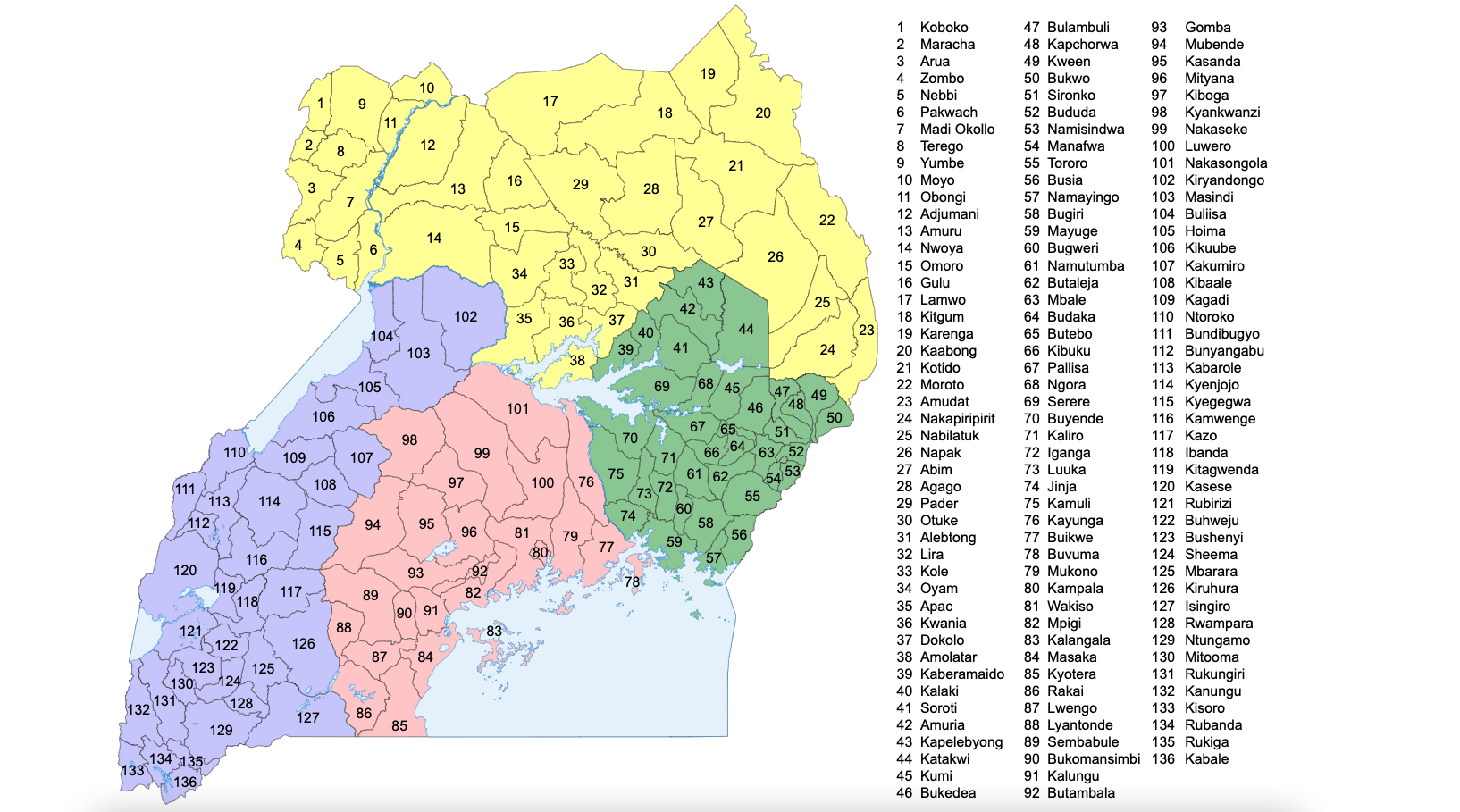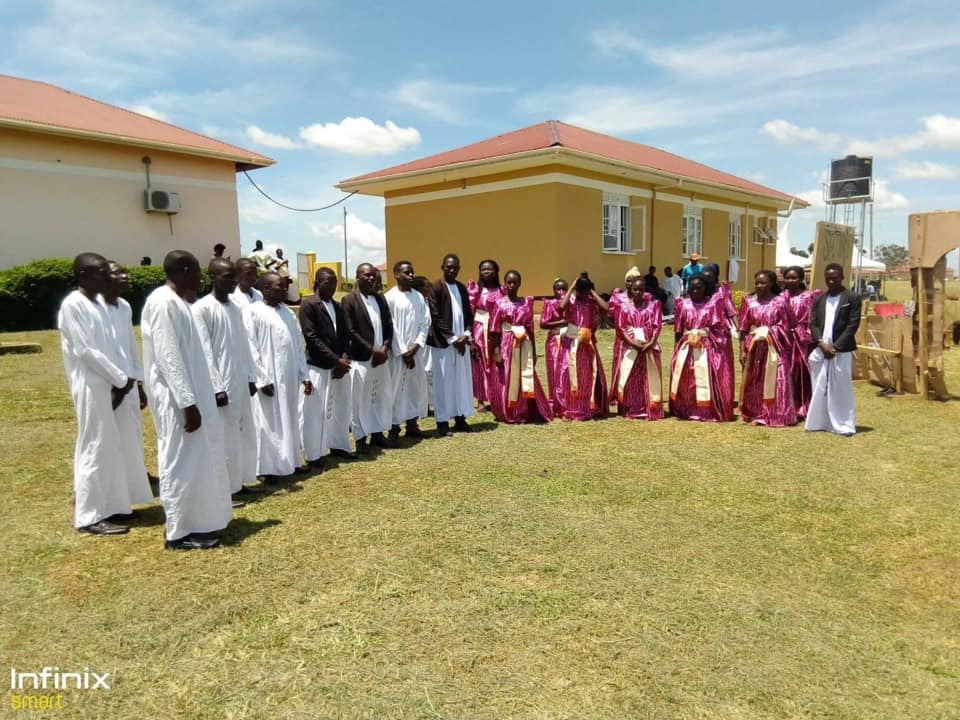|
Nakaseke
Nakaseke is a town in Nakaseke District in the Central Region of Uganda. It is the main municipal and commercial center of the district. However, the political and administrative capital in the district is Butalangu. Location Nakaseke is approximately by road, northwest of Kampala, the capital and largest city of Uganda. The road from Kampala to Wobulenzi, a distance of about , is all-weather tarmac, with the last to Nakaseke on a gravel-dirt road. The coordinates of the town are 0°43'48.0"N, 32°24'54.0"E (Latitude:0.7300; Longitude:32.4150). Nakaseke Town sits at an average elevation of above mean sea level. Overview Nakaseke Town Council was carved out of Nakaseke sub-county and was demarcated in 2010. The town, in its early years, faces challenges related to physical planning. Most of the people in Nakaseke are Baganda, the largest ethnic group in the Central Region. An estimated 59.2 percent of the Nakaseke community is literate, which is largely limited to the Lugand ... [...More Info...] [...Related Items...] OR: [Wikipedia] [Google] [Baidu] |
Nakaseke District
Nakaseke District is a district in Central Uganda. It is named after Nakaseke, the largest town in the district. However, the district headquarters are located at Butalangu. Location Nakaseke District is bordered by Nakasongola District to the north and northeast, Luweero District to the southeast, Wakiso District to the south, Mityana District to the southwest. Kiboga District and Kyankwanzi District lie to the west and Masindi District lies to the northwest. Butalangu, the location of the district headquarters, lies approximately , by road, north of Kampala, the capital of Uganda and the largest city in the country. The coordinates of the district are:00 44N, 32 25E. Overview Nakaseke District is divided into the following administrative units: 1. Kapeeka 2. Ngoma 3. Kinyogoga 4. Wakyaato 5. Nakaseke Town Council 6. Kasangombe 7. Semuto and 8. Kikamulo. It estimated that 59.2 percent of the Nakaseke District community is literate, which is largely limited to the local L ... [...More Info...] [...Related Items...] OR: [Wikipedia] [Google] [Baidu] |
Nakaseke Hospital
Nakaseke General Hospital, also Nakaseke Hospital, is a public hospital in the Central Region of Uganda. Location The hospital is located in the town of Nakaseke, in Nakaseke District, in the part of the country known as the Luweero Triangle. Its location is approximately , by road, northwest of Mulago National Referral Hospital. This is approximately , by road, northwest of Bombo Military Hospital, the nearest bigger hospital. The coordinates of Nakaseke General Hospital are:0°43'06.0"N, 32°23'56.0"E (Latitude:0.718344; Longitude:32.398893). Overview Nakaseke hospital is a rural hospital built in the 1960s by the administration of Prime Minister Milton Obote. It serves Nakaseke District together with some parts of the neighboring districts of Luweero, Wakiso, Nakasongola and Mityana. During the National Resistance Movement War in the early 1980s, the hospital served as a major health facility for the NRA guerrillas. Dr. Ronald Bata (R.I.P), the then Medical Director of the ... [...More Info...] [...Related Items...] OR: [Wikipedia] [Google] [Baidu] |
Butalangu
Butalangu is a town in Central Uganda. It is the political and administrative center of Nakaseke District. Location Butalangu is located west of Luweero, the largest town in the sub-region. The Luweero–Butalangu road measures approximately . The geographical coordinates of Butalangu are:0°49'22.0"N, 32°14'34.0"E (Latitude:0.822778; Longitude:32.242778). Population During the national census and household survey of 27 and 28 August 2014, the Uganda Bureau of Statistics (UBOS), enumerated the population of Butalangu at 3,873 people. Points of interest The Uganda National Roads Authority (UNRA) has requested for parliamentary approval to tarmac the Luweero–Butalangu Road from gravel surface to class II bitumen with drainage channels and culverts. The improvements are budgeted at US$40 million co-financed by the Arab Bank for Economic Development in Africa (BADEA) and the OPEC Fund for International Development (OFID), and are expected to last two years. A modern abattoir ... [...More Info...] [...Related Items...] OR: [Wikipedia] [Google] [Baidu] |
Central Region, Uganda
The Buganda region is one of the four regions in the country of Uganda. As of Uganda's 2014 census, the region's population was . It is coterminous with the Kingdom of Buganda, one of the ancient Africa Africa is the world's second-largest and second-most populous continent, after Asia in both cases. At about 30.3 million km2 (11.7 million square miles) including adjacent islands, it covers 6% of Earth's total surface area ...n monarchies that are constitutionally recognised in Uganda. Districts , the Central region contains 24 districts: References External links Google Map of the Central Region of Uganda {{Authority control Regions of Uganda ... [...More Info...] [...Related Items...] OR: [Wikipedia] [Google] [Baidu] |
Districts Of Uganda
As of 17 November 2020, Uganda is divided into 136 districts and the capital city of Kampala, which are grouped into four administrative regions. Since 2005, the Ugandan government has been in the process of dividing districts into smaller units. This decentralization is intended to prevent resources from being distributed primarily to chief towns and leaving the remainder of each district neglected. Each district is further divided into Counties of Uganda, counties and municipalities, and each county is further divided into Sub-counties of Uganda, sub-counties. The head elected official in a district is the chairperson of the Local Council (Uganda), Local Council five (usually written with a Roman numeral V). Below are population figures from the 2014 census (tables show population figures for districts that existed in 2014). __NOTOC__ Districts created since 2015 In September 2015, the Parliament of Uganda created 23 new districts, to be phased in over the next four years ... [...More Info...] [...Related Items...] OR: [Wikipedia] [Google] [Baidu] |
Luweero Triangle
The Luweero Triangle, sometimes spelled Luwero Triangle, is an area of Uganda north of the capital Kampala, where, in 1981, Yoweri Museveni started the guerrilla war that propelled him and his National Resistance Movement into power in 1986. The area was notorious for the persecution of civilians during the Luweero War, between the rebel National Resistance Army and the government of Milton Obote. Many residents were either forcibly recruited or killed by both sides during the five-year Ugandan Bush War, as Museveni's guerrilla forces started their advance from Kyankwanzi southeast toward Kampala. The following Buganda districts constitute the Luweero Triangle: * Kiboga District * Kyankwanzi District, formerly part of Kiboga * Nakaseke District, formerly part of Luweero * Nakasongola District, formerly part of Luweero * Luweero District * Mubende District * Mityana District, formerly part of Mubende * Wakiso District, formerly part of Mpigi See also * Luweero District Luweero ... [...More Info...] [...Related Items...] OR: [Wikipedia] [Google] [Baidu] |
List Of Cities And Towns In Uganda
This is a list of cities and towns in Uganda: The population data are for 2014, except where otherwise indicated. The references from which the estimated populations are sourced are listed in each article for the cities and towns where the population estimates are given. Twenty largest cities by population The following population numbers are from the August 2014 national census, as documented in the final report of November 2016, by the Uganda Bureau of Statistics (UBOS). Cities In May 2019, the Cabinet of Uganda approved the creation of 15 cities, in a phased manner, over the course of the next one to three years, as illustrated in the table below. The 7 of the 15 cities started operations on 1 July 2020 as approved by the Parliament of Uganda. Cities and towns References External links Uganda: Regions, Major Cities & Towns - Population as per 2014 Census {{Africa topic, List of cities in Uganda, List of cities in Uganda Cities A city is a human s ... [...More Info...] [...Related Items...] OR: [Wikipedia] [Google] [Baidu] |
Flag Of Uganda
The flag of Uganda ( Ugandan Languages: ''Bendera ya Uganda'') was adopted on 9 October 1962, the date that Uganda became independent from the British Empire. It consists of six equal horizontal bands of black (top), yellow, red, black, yellow, and red (bottom); a white disc is superimposed at the centre and depicts the national symbol, a grey crowned crane, facing the hoist's side. During the colonial era the British used a British Blue ensign defaced with the colonial badge, as prescribed in 1865 regulations. Buganda, the largest of the traditional kingdoms in the colony of Uganda, had its own flag. However, in order to avoid appearing to give preference to one region of the colony over any other, the British colonial authorities selected the crane emblem for use on the Blue ensign and other official banners. History When the Democratic Party ruled the country, a design for flag was proposed. It had vertical stripes of green-blue-green, separated by narrower yellow stripes, an ... [...More Info...] [...Related Items...] OR: [Wikipedia] [Google] [Baidu] |
Baganda
The Ganda people, or Baganda (endonym: ''Baganda''; singular ''Muganda''), are a Bantu ethnic group native to Buganda, a subnational kingdom within Uganda. Traditionally composed of 52 clans (although since a 1993 survey, only 46 are officially recognised), the Baganda are the largest people of the bantu ethnic group in Uganda, comprising 16.5 percent of the population at the time of the 2014 census. Sometimes described as "The King's Men" because of the importance of the king, or Kabaka, in their society, the Ganda number an estimated 5.56 million in Uganda. In addition, there is a significant diaspora abroad, with organised communities in Canada, South Africa, Sweden, the United Kingdom, and the United States. Traditionally, they speak Luganda. History Early history The early history of the Ganda is unclear, with various conflicting traditions as to their origins. One tradition holds that they are descendants of the legendary figure of Kintu, the first human accordi ... [...More Info...] [...Related Items...] OR: [Wikipedia] [Google] [Baidu] |
Populated Places In Central Region, Uganda
Population typically refers to the number of people in a single area, whether it be a city or town, region, country, continent, or the world. Governments typically quantify the size of the resident population within their jurisdiction using a census, a process of collecting, analysing, compiling, and publishing data regarding a population. Perspectives of various disciplines Social sciences In sociology and population geography, population refers to a group of human beings with some predefined criterion in common, such as location, race, ethnicity, nationality, or religion. Demography is a social science which entails the statistical study of populations. Ecology In ecology, a population is a group of organisms of the same species who inhabit the same particular geographical area and are capable of interbreeding. The area of a sexual population is the area where inter-breeding is possible between any pair within the area and more probable than cross-breeding with ind ... [...More Info...] [...Related Items...] OR: [Wikipedia] [Google] [Baidu] |
Uganda Bureau Of Statistics
The Uganda Bureau of Statistics ("UBOS") is an agency of the Ugandan government. Formed by the Uganda Bureau of Statistics Act, 1998, the agency is mandated to "coordinate, monitor and supervise Uganda's National Statistical System". Location The headquarters of UBOS are located in Statistics House, at Plot 9 Colville Street on Nakasero Hill, in Kampala, Uganda's capital and largest city. This is at the corner of Colville Street and Nile Avenue. The coordinates of Statistics House are 0°18'58.0"N, 32°35'05.0"E (Latitude:0.316111; Longitude:32.584722). Overview The agency is supervised by the Uganda Ministry of Finance, Planning and Economic Development. UBOS is governed by a seven-person board of directors. Its scope of work includes conducting a national population census at least once every 10 years or so. The last national census was conducted in August 2014. The exercise cost an estimated UGX:75 billion and created an estimated 150,000 temporary jobs. The agency also p ... [...More Info...] [...Related Items...] OR: [Wikipedia] [Google] [Baidu] |
Uganda Ministry Of Health
The Ministry of Health is a cabinet-level government ministry of Uganda. It is responsible for planning, delivering, and maintaining an efficient and effective healthcare delivery system, including preventive, curative, and rehabilitative services, in a humane, affordable, and sustainable manner. The ministry is headed by Minister of Health Jane Aceng. Location The headquarters of the ministry are located at Plot 6 Lourdel Road, in the Wandegeya neighborhood, Kampala Central Division, in Kampala, Uganda's capital and largest city, about north of the city's business district. The coordinates of the building are 0°19'59.0"N, 32°34'39.0"E (Latitude:0.333044; Longitude:32.577486). Subministries * State Minister for Health (General Duties) * State Minister for Primary Healthcare - Joyce Moriku. List of ministers * Jane Aceng (6 June 2016 - present) * Elioda Tumwesigye (1 March 2015 - 6 June 2016) * Vacant (18 September 2014 - 1 March 2015) * Ruhakana Rugunda (23 May 2013 - 18 S ... [...More Info...] [...Related Items...] OR: [Wikipedia] [Google] [Baidu] |





